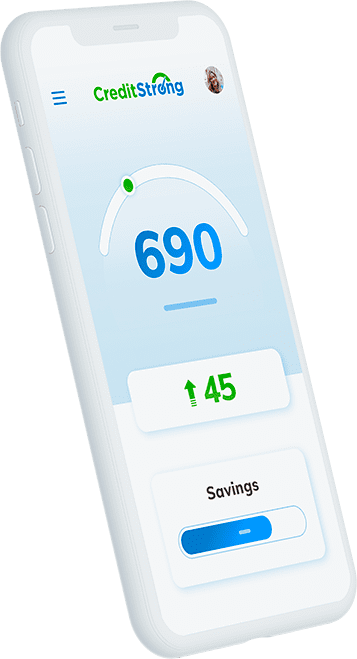Overcoming Insufficient Credit History

Build strong credit
while you save

Just getting started on your credit journey? Then you’ll likely be in the catch-22 of having no credit and needing to have credit to build credit. This is often referred to as having an insufficient credit history.
The initial sting of getting your credit application denied doesn’t feel great, but there are ways to overcome it. We’ll cover what insufficient credit history is, the reasons behind it, and how to build credit experience.
What Does Insufficient Credit History Mean?
You may have heard the terms unscorable, limited credit history, or no credit. They all fall in the same category–insufficient credit history. This is the response you’d get back from a bank or financial institution as the reason they’ve denied your application for a new credit account.
It means you don’t have enough credit experience to be given a credit score yet. Your credit score and credit history are tools that lenders use to determine if it’s safe to lend you money. It tells them how likely you are to pay your bills on time and if you’ve used your credit responsibly.
What does that mean for you? If your credit application is denied due to insufficient credit history, it means you’ll face some difficulties in getting approved for a new account due to a lack of experience.
If you are approved it often equals high-interest rates or a required security deposit.
While it might block you from getting a new car loan or credit card, it’s not the worst. Think of it as starting with a clean slate. It’s much easier to build on no credit history compared to having bad credit. You just have to find a lender that’s willing to give you a chance.
What Causes Insufficient Credit History?
There are a few different reasons why you might have an insufficient credit history. Since everyone’s credit history is unique to them, there are several paths to reach this result. The good news is that these are easy to fix once you identify the problem.
No Open Credit Accounts
Most times when you’re listed as having no credit it’s because you don’t have student loans, credit cards, personal loans, or any other accounts under your name. Without a record of payment history, lenders are in the dark on how you would manage payment obligations.
In turn, credit reporting agencies won’t have anything to base your credit score off of without any recorded credit information. So instead of starting you off at the bottom of the credit score range, they give you no score at all.
This might seem harsh, but it may put you in a better position than a borrower with credit issues. We’ll get into that later.
Your Accounts Aren’t Old Enough
Let’s say you’ve recently opened your first new credit card or loan account. It’s showing on your credit report, but you still don’t have a score. So what gives?
Well if the accounts on your credit report are still under six months old, you don’t have a long enough length of credit history for credit bureaus to calculate a score yet. So you’ll need to have a little more patience.
According to FICO, you need at least one open account reporting to the credit bureaus for at least six months to generate a FICO score. Opening a new credit account is a step in the right direction, but you still need time to develop a payment history when you’re starting from scratch.
You Have a Thin Credit File
Sometimes opening one new credit account and paying on time for six months won’t cut it. This is usually the case when you’re applying for larger loans. Think car loans or a mortgage. For example, if you’re applying for a mortgage but only have one credit card with a small credit limit.
You’ll likely get the same “insufficient credit” response from any lender you choose. This is because you’re seen as having a thin credit file.
With just one account on your credit report, there’s not enough information for most lenders to approve a large loan. Even if your payment history is on point and the account has been open for a year or two.
When an underwriter reviews a credit report for a large loan like a mortgage, they want to see diverse credit history. One that consists of revolving accounts, installment loans, and other forms of credit that demonstrate experience in handling multiple types of accounts successfully.
Is Having Insufficient Credit History the Same as Having Bad Credit?
Short answer: no.
While you may get applications denied similar to someone with bad credit, they’re not the same. Insufficient credit doesn’t mean you’ve done anything wrong. It just means you’re inexperienced. Borrowers with bad credit have missed payments and may have potentially defaulted on a loan.
Someone with bad credit has developed a history of bad habits with the accounts on their credit report. This makes them a high risk to lenders since they’ve already demonstrated how they manage their finances and accounts.
When you’re credit invisible, lenders don’t know what to make of you yet. So it doesn’t carry the same negative connotations as bad credit. It still makes you a high risk to lenders, but for different reasons. Mainly because there’s no telling how you’ll manage future accounts.
All in all, you’re more likely to catch a break with insufficient credit than with bad credit.
How Do I Get Rid Of Insufficient Credit History?
The only way to nix your lack of credit history is by building credit. There are ways you can do this without running tons of credit checks and getting more denials. While these can get you out of the no-credit club, you’ll still have to be consistently responsible to reach a good credit score.
Open a Secured Credit Card
Find a credit card issuer that works with beginner borrowers for your best chances of getting a new credit card. If you manage to get an unsecured credit card, you may start out with a small credit limit which helps the credit card issuer keep their risks low.
Most times the credit card company may start you out with a secured credit card. You’ll put down a security deposit which becomes your credit limit. From there you would periodically use the card and pay it off by the due date each month.
Be sure to keep your credit utilization below 30% of your total credit limit as you use the secured card. This helps you build a good credit score as well. Once you’re ready to graduate to an unsecured credit card, you can apply for one and get your security deposit back.
Become an Authorized User
Another way to fix the issue of being credit invisible is by asking someone you trust to add you as an authorized user to their credit card. Ideally, the person should have good credit. They don’t have to grant you the ability to make purchases for it to increase your credit score.
Being an authorized user adds their established account to your credit report. As long as the primary cardholder continues making monthly payments on time, you’ll be building a good credit history. On the flip side, if they miss payments it can negatively impact your credit score.

Open a Credit Builder Loan
A credit builder loan has a few advantages for people with insufficient credit. It helps you by:
- Reporting payment history to major credit bureaus
- Diversifying your credit mix
- Adds an installment account to your credit file
One of the best credit builder loans you can get is through CreditStrong. Our affordable payment plans for personal accounts start at $15 a month. We report your monthly payments to all three major credit bureaus, helping you build up to 120 months of credit history.
All without doing a hard credit check.
Plus, at the end of your loan term, you’ll unlock the savings account you’ve built which can help you in the next stage of your credit journey. Get started building your credit today with CreditStrong!
Use Alternative Credit Building
Traditional credit reporting doesn’t take certain monthly payments into account that you’re already making. Things like your:
- Cell phone bill
- Utilities
- Rent payments
- Streaming services
So even though you’re paying them on time each month, you’re not going to see your credit score budge. That’s where alternative credit reporting comes in.
Services like Experian Boost help people with little to no credit develop a payment history with the bills they’re already paying. It requires you to grant access to your bank account transaction history which then tracks the eligible bills you’re paying each month to increase your score.
It also provides you with a free credit score each month so you can track your progress. When you pair this with the other tips to get rid of insufficient credit history, you may see a dramatic increase in your credit score.
How Long Does It Take To Fix Insufficient Credit History?
It’s important to be realistic about how long it will take to build credit after following these tips. If you’re starting from scratch, it’ll take six months for you to build a credit history.
Make no mistake, you won’t have excellent credit after six months of on-time payments. However, if you maintain practices like paying your bills on time and keeping your revolving balances low, you can strengthen your credit within at least a year.
One of the main factors in the strength of your credit history is the age of your accounts. So as you continue to make on-time payments and keep your credit accounts open, you’ll see your score improve even more.
Can I Get A Loan With Insufficient Credit History?
Yes, you can still get a loan with insufficient credit history. You’ll likely need some help to get it done though. Unless you’re going for CreditStrong’s credit builder loan, you’ll need a co-signer to help you qualify if you’ve been labeled as having no credit.
This is a tricky situation to manage. The co-signor for your loan will have a hard pull done on their credit to help you qualify. By co-signing for you, it also makes them responsible for repaying the loan if you stop making scheduled payments. That can cause huge problems.
This doesn’t just impact your credit, it impacts your co-signer’s credit too. So it’s imperative to be considerate of the person helping you by making all of your monthly payments on time. If you can’t find a co-signer there are other options too.
You might also try getting a secured loan. This is similar to the secured credit cards we talked about earlier except it’s in the form of an installment loan. With a secured loan, the lender is more likely to approve because you’re using collateral such as a car or savings account.
The value of the collateral informs the total loan amount. However, if you don’t make your payments the lender can take the collateral back.
You can also consider making a large down payment on the loan to help you get approved. Paired with proof of sufficient funds from income, it shows the lender that you’re capable of meeting future payments.
Overall insufficient credit history isn’t the end of the world. It just means you’ll need to improve your experience with handling credit. You can do this by opening new accounts, using alternative credit reporting, or having a trusted person add you as an authorized user.
If you’re serious about strengthening your credit file, you’ll be able to start seeing good results within six months to a year of opening your first account.
CreditStrong helps improve your credit and can positively impact the factors that determine 90% of your FICO score.
